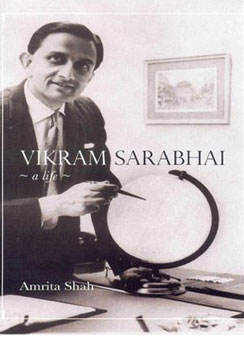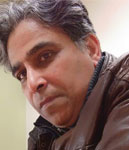In her definitive biography of Dr. Sarabhai (1919 -1971), journalist and writer Amrita Shah says, “When exactly Vikram came up with the notion of a space programme for India is not known. R. G. Rastogi, his former student, claims to have heard him talk prophetically of setting up a rocket-launching programme “by 1963” as far back as in the 1950s. Praful Bhavsar, who had taken a leave of absence from PRL (the Physical research Laboratory in Ahmedabad) to do a post-doctorate work at the University of Minnesota, recalls Vikram telling him something similar in 1959, and adding that he would want him to return to India to help.”
To think that in barely 12 years after the emergence of a deeply impoverished but free India, one man should think in terms of setting up a space programme was quite extraordinary. Shah’s 2007 book Vikram Sarabhai: A Life describes in some dramatic details the uncertainties that attended the launch of the Nike-Apache rocket supplied by the National Aeronautics and Space Administration (NASA). From a leak developing in the hydraulic system of the crane moving the rocket, to a student discovering a worker still fiddling with the launcher controls just before the blast-off, India’s nascent space programme was attended by considerable drama.
“At 6.25 p.m. (on November 21,1963), the rocket streaked away into the gathering dusk. Minutes later, a sodium vapour cloud emerged high above, tinged orange by the setting sun,” Shah writes. Dr. Sarabhai sent home a telegram that said ‘Gee whiz wonderful rocket shot.” Just one day after the Nike-Apache launch, Dr. Sarabhai spoke of an Indian satellite launch vehicle. Unlike space programme elsewhere, where the dominant purpose was militaristic, Dr. Sarabhai had a development-oriented, even education-focused vision. His multi-layered vision included the use of space programme for purposes such as weather forecasting.
In an email interview with Mayank Chhaya, Shah talks about Sarabhai‘s motivation for his space endeavours, the means through which he had found a way of meeting both his social and scientific goals.
We are approaching the 63rd anniversary of the first rocket launch by India on November 21, 1963. Why do you think India’s space programme, pioneered by Dr. Vikram Sarabhai has not found a comprehensive chronicle?
Much of modern Indian history remains to be written. That said, some good books have been written on the space programme, Gopal Raj’s Reach for the Stars: The Evolution of India’s Rocket Programme, for example.
In your biography of Dr. Sarabhai, you capture in some detail the excitement of that day and the challenges that the project faced. What do you think motivated Dr. Sarabhai to think of space programme barely a decade and half after independence?
Space was an extension of Vikram Sarabhai’s scientific interest in studying cosmic rays. Unlike most scientists, Sarabhai was possessed of a vision that transcended scientific discovery. He wanted to use science for social upliftment and in space technology he saw an opportunity to achieve this goal. It is true that space programmes were generally initiated for military purposes and the Indian space programme struck a pioneering path. Sarabhai believed that as a poor, underdeveloped country, India needed to prioritise literacy and economic progress. One can trace his strong identification with the national interest to his family’s deep involvement in the freedom struggle; many members of his family, including his sister Mridula had been jailed and taken great risks. His aunt Ansuya had founded a union of textile labourers. The family‘s closeness to Mahatma Gandhi may also have had an impact in shaping his commitment.
Why the Indian government under Nehru and Indira Gandhi supported his idea of a space programme is not as clear. Both leaders had great faith in science and its potential role in national development. They may have trusted Homi Bhabha and Sarabhai as specialists who knew what they were doing.
At the core of his vision was the idea of leapfrogging development using technology in defiance of the more popular approach of incremental steps. How do you explain that sense of defiance?
Both Bhabha and Sarabhai believed in using the western experience to leapfrog, i.e., make rapid strides. I would say it was one view, and at a time when so many things were beginning and taking shape for the first time in a newly free country, I don’t know if it was necessarily radical.
Would you say that for someone who created an inordinately diverse number of institutions, unlike any other Indian of any generation before or since, that space was Dr. Sarabhai’s core calling?
No. Sarabhai had a complex vision in which all his activities were interconnected. The SITE (Satellite Instructional Television Experiment) which involved taking television to remote villages for example, called upon managerial capabilities, software development, feedback etc., – you can see that building a management college, a market research agency, the community science centre etc., (all of Sarabhai‘s initiatives) were all apiece with this vision. Yes, space did have a very special place in his heart, and it was the means through which he had found a way of meeting both his social and scientific goals.
This is perhaps talking in the abstract, but do you think there would have been a space programme in India without Dr. Sarabhai?
Yes. I believe at some point there would have been a space programme. It might have gone the disappointing way of many of India‘s scientific institutions; it might have been more military – a wing of DRDO (Defence Research and Development Organisation) maybe. Sarabhai’s vision, his ability to inspire, and to combine the idealistic with the practical, and of course his stature, gave the space programme a foundation and a profile. Dr. Kasturi Rangan, former head of ISRO told me that the space programme was still realising Sarabhai’s vision 30 years after his death, which testifies to his far sightedness.



 [/column]
[/column]